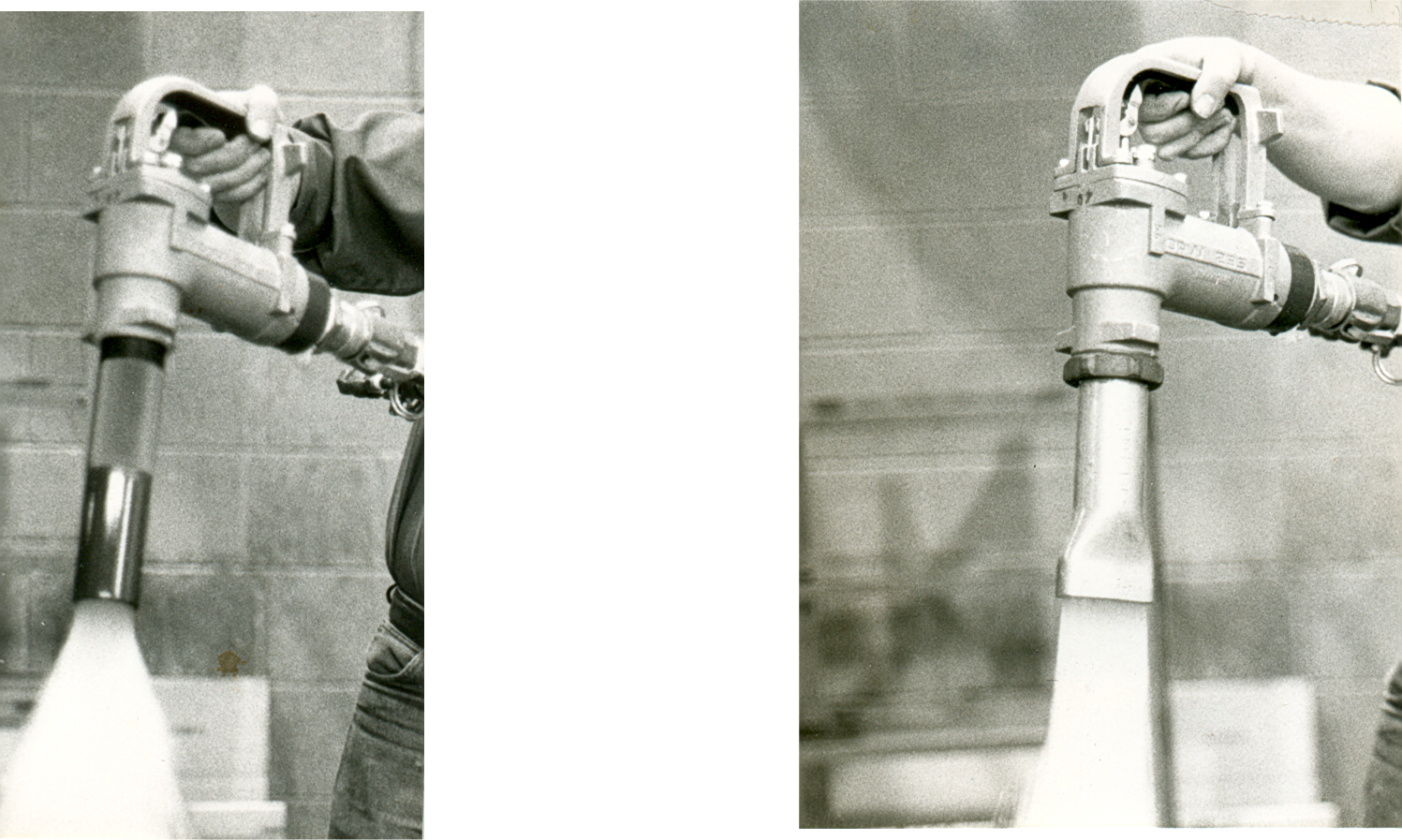Did you know that there are 5 times more aviation accidents caused by water and dirt in the fuel than from misfueling (pumping the wrong fuel into an airplane)? We heard a supposedly responsible representative of an aircraft manufacturer say that this means the industry should concentrate on the water and dirt problem instead of the misfueling problem. What a monkey!
We already do many things to keep fuel clean and dry but what has been done in the past to prevent misfueling? The answer is almost nothing. Oh yes, we do label trucks, tanks, pipes and fill stands, but not always. The aircraft are supposed to have placards stating what fuel to use, but they do not always. Bottom loading equipment can easily be keyed with product selectors that have been on the market for 30 years but they are not always installed. In fact, only a small fraction of the apparatus is so equipped.
Misfueling accidents all have one thing in common — human error.
After an air show, an experienced and highly professional pilot watched his light twin being refueled with a truck marked “jet fuel”. Fortunately, he crash-landed safely.
A very young, untrained line serviceman put jet fuel in a cabin twin because he saw the word TURBO in the name of the airplane. Seven people were killed.
A dealer had a practice of keeping the unmarked jet fuel truck in one location and the unmarked avgas truck in another. Guess what happened. Someone made a mistake in parking the jet truck. The accident was inevitable.
A corporate pilot arrived at one of the world’s largest airports and deliberately specified that he did not want fuel. He got it anyhow, jet fuel in his avgas cabin twin. The dealer caught this error before the pilot departed.
So you see, it is always human error. Fortunately, someone decides to do something positive about this crazy situation. The General Aviation Manufacturers Association promoted a campaign which is summarized below:
- The word TURBO has been eliminated from airplane names.
- Decals were designed and distributed for labeling filler caps.
- Bands were designed for labeling all overwing refueling nozzles.
- A keying system was devised to prevent a large jet fuel nozzle filler spout from entering a smaller avgas filler opening.
The fourth action is the one that is the most important, because it overcomes human error. Research showed that 74% of avgas aircraft have filler openings that are less than 2.3” in diameter. Therefore, only 26% of the aircraft fleet needed to be modified with smaller openings if all jet fuel spouts on overwing nozzles were made larger. Through some very clever design, Shaw Aero, the largest manufacturer of caps and filler openings, developed an insert to reduce the size of large openings. These kits are offered by the airframe manufacturers, such as Piper, Cessna, Beech, Mooney and Aero Commander. All new avgas aircraft manufactured after early 1984 have a small filler opening.
The spouts on all overwing nozzles prior to 1984 were sized to fit through the smallest filler openings. However, to make the interference system work, every overwing nozzle that dispensed jet fuel had to have a new spout that is large enough so it would not enter an avgas opening. The problem was that some jet fueled aircraft have a “D” shaped opening; they are not round. The solution was a spout that is oval shaped. It measures 2.6” at the largest point so it will not enter a 2.3” opening, but it will enter the “D” shaped opening.
So now you may think that the problem of misfueling is solved. Unfortunately, it is not solved because of several other problems:
- The FAA has not developed a clear, consistent policy. For example, owners of Cessna 300 and 400 series aircraft received AD’s that mandated installation of restrictor kits but owners of Beechcraft twin engined aircraft only received Service Bulletins; compliance is not mandatory. The Piper AD only applies to Navajo and Aerostars, not to Aztecs! Very Confusing!!
- There is no law that forces a dealer, FBO or oil company to install the new oval spouts on their jet fuel nozzles.
- After all of the heavy research that went into the design of the system, some aircraft that use jet fuel have been found to have filler openings that are too small for the oval spout. Fortunately, some of these can be modified to the large size but others remain a problem. More about these cases will be found later in this article.
- The real “zinger” in the program is people who “bad-mouth” the idea, just because it is different from what they are accustomed to. For Example:
- Some line personnel said that the new oval spout causes excessive splash-back in the Cessna Citations and Beech King Airs. To investigate this, tests were run that showed that round spouts also will cause the same splash-back problem at the same flow rate. The difficulty is that the fuel cannot flow down the slope (dihedral) of the wing rapidly because of the small holes in the wing structure.
- Some people say absolutely that the shape of the oval spout causes a spray pattern that results in splash-back. This is pure “bunk” – look at these photographs of the fuel flow pattern.

- Some people have stated that the flow rate is reduced by the new spout, as compared to the 1½” diameter spout it replaces. Tests by Cessna and OPW prove this is simply not true.
- An article was printed stating that the flow in a round spout is laminar but not in the oval spout. Fantastic!! Try to find a qualified engineer who will agree that laminar flow can exist at 9 feet per second downstream of a cone strainer. That is the velocity in a 1½” round spout at 50 gpm. Man! — That is turbulent flow, not “laminar”.
“People” problems are an aggravation but hopefully they can be solved by real facts. Big problems? Yes, there are a few. The biggest one is the Hawker Siddley 125. There are 200 of these aircraft in the U.S.A. (through the 600 Series) that have filler necks that are about 1/4” too small for the oval shaped spout to enter. Obviously, these executive jets must be refueled somehow but FBO’s resisted installing the new spout “just in case” a HS125 landed at their airport. This problem was solved by British Aerospace (the manufacturer) when they developed an adapter spout for HS125 operators. The crew simply hands this adapter to the refueler who slips it on to his oval spout.
But what is to be done about the helicopters that have been found to have small filler necks? These are the Wessex, Boelkows, Puma, Dauphin, Gazelle, Twin Star and the extended range mods for the Hiller OV-12 and the Bell Jet Ranger. Eventually, it is hoped they will all be modified with large filler necks. There is an adapter available from Fjord Aviation Fueling Products. Clearly, this is not a solution to the misfueling problem because someone could use the adapter and put jet fuel in an avgas airplane. However, the adapter was purposely planned to be awkward, to encourage operators to remove it unless it is absolutely needed to refuel one of the listed aircraft.
The end of the story is liability!!!
Regardless of aggravations and inefficiencies that can be blamed on the oval spout, do you think that a misfueling law suit can be won by an FBO because the new spout was not installed? The reason “it would not fit in 200 executive jets and helicopters” that represent possibly 1 percent of the jet fleet in the USA would mean nothing to a jury.
All is not lost! Think of it this way. Any jet fuel nozzle that is equipped with the oval spout will not be capable of putting jet fuel in 74% of the avgas aircraft fleet. That is a real accomplishment!
In conclusion, we feel that the new spouts simply must be used regardless of aggravations they create. People who refuel aircraft do make mistakes, like all other people in this world. No FBO can afford not to install the new spouts and no owner of an aircraft with a large filler opening can afford not to have the restrictors installed.

